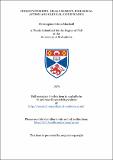Files in this item
Cholecystokinin: measurement, biological action and clinical significance
Item metadata
| dc.contributor.advisor | Steward, M. W. | |
| dc.contributor.author | Marshall, Christopher Edwin | |
| dc.coverage.spatial | 160 p. | en_US |
| dc.date.accessioned | 2018-07-09T10:15:17Z | |
| dc.date.available | 2018-07-09T10:15:17Z | |
| dc.date.issued | 1979 | |
| dc.identifier.uri | https://hdl.handle.net/10023/15102 | |
| dc.description.abstract | This thesis describes in full the development of a biological method of estimating cholecystokinin (CCK) in human serum by superfusion of rabbit gall-bladder strips, from the early stages of the manual technique, which would estimate approximately twelve samples per day, to the more sophisticated and clinically useful automated technique of today which can estimate up to forty eight sample solutions in duplicate each day. In developing this bioassay for CCK it was necessary to determine whether the gall-bladder preparation was stable for the duration of the experiment, and also whether or not there were other factors influencing the response of the gallbladder strips to a given stimulus. It was also necessary to determine whether the assay was entirely specific for CCK in human serum and to counteract any possible degradation of CCK during processing and storage of serum. In the light of the findings during the above experiments the technique was modified to eliminate errors that would otherwise be made in estimating the CCK content of a serum sample. Since our attempts to set up a radioimmunoassay were unsuccessful a comparison of this bioassay was made with another groups' radioimmunoassay. Although no direct comparison could be made as the two assays measure CCK in totally different units, nevertheless a straight line relationship between the two very different methods was found, and this experiment led directly to the discovery by bioassay of CCK mimicking substances in serum. The action of trypsin on CCK has been clearly demonstrated and its ability to release the C-terminal octa and more probably the dodeca peptide, both of which are considerably more active than the full molecule, is beyond question. It is therefore important that an enzyme inhibitor is added to blood samples to prevent this spontaneous breakdown of more active fragments and prevent false readings of serum cholecystokinin activity. During chromatographic investigations a new molecule in human serum which possessed cholecystokinetic activity but had a molecular weight in excess of 30,000 (c/f 3,900 for normal CCK) was discovered. This molecule appeared to predominate in the fasting state but to decrease in concentration during the response to a meal. The practical use of measuring serum CCK is demonstrated in some clinical trials in which CCK's target organs are removed or the stimulation for its release is modified by various surgical procedures. Some interesting changes are noted. | en_US |
| dc.language.iso | en | en_US |
| dc.publisher | University of St Andrews | |
| dc.subject.lcc | QP99.3C5M2 | |
| dc.subject.lcsh | Plasma and serum | en |
| dc.title | Cholecystokinin: measurement, biological action and clinical significance | en_US |
| dc.type | Thesis | en_US |
| dc.type.qualificationlevel | Doctoral | en_US |
| dc.type.qualificationname | PhD Doctor of Philosophy | en_US |
| dc.publisher.institution | The University of St Andrews | en_US |
This item appears in the following Collection(s)
Items in the St Andrews Research Repository are protected by copyright, with all rights reserved, unless otherwise indicated.

